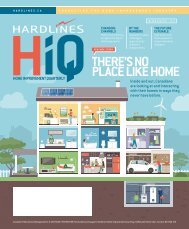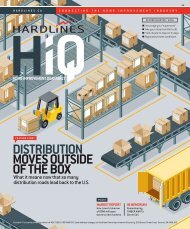HHIQ_3Q_17_Complete
Create successful ePaper yourself
Turn your PDF publications into a flip-book with our unique Google optimized e-Paper software.
MERCHANDISING<br />
FLE<br />
BRICKS-AND-MORTAR STORES<br />
SHOULD RELY ON THEIR SOLID FOUNDATIONS<br />
Competing with e-commerce doesn’t have to be as hard as you think. Bricks-and-mortar retailers just need to focus<br />
on their strengths and the edge they have over the internet to continue to jockey for that all-important market share.<br />
BY ROB WILBRINK<br />
B<br />
ricks-and-mortar retailers facing<br />
the new realities of online selling<br />
are looking for ways to defend<br />
against eroding sales. Brand-name manufacturers<br />
are also under threat as a new<br />
breed of online competitors, often sourcing<br />
from the same offshore factories, are<br />
commoditizing their products.<br />
One of the best ways both sides of the<br />
industry are defending themselves is by<br />
increased emphasis on display. A welldisplayed<br />
product does several things. It<br />
makes the customer aware of its availability<br />
for purchase and makes it much easier to<br />
evaluate whether that product meets their<br />
needs for style, quality, colour, size, and<br />
price point. This is much more difficult<br />
to do online, which is one reason returns<br />
average about 15 percent of sales for online<br />
purchases—about two and a half times as<br />
high as in-store purchases.<br />
DISPLAYS ARE CRUCIAL<br />
A well-organized display can lead the buyer<br />
through a selling process that helps them<br />
make the right selection. Viewing, touching,<br />
and feeling the product is a much better<br />
way to evaluate it than just seeing words and<br />
pictures on a screen.<br />
Proper displays absolutely reduce shrink<br />
and write downs. Customers don’t like to<br />
buy ripped boxes, yet feel compelled to tear<br />
open products that aren’t on display to do<br />
their evaluations and inspections. Without<br />
displays, unsellable product multiplies,<br />
wastes valuable shelf space, and fuels customer<br />
frustration.<br />
Having the product in the store in the first<br />
place is a key part of driving sales for most<br />
products. The box stores taught us this.<br />
A high-volume building centre I was<br />
responsible for in the late ’90s was looking<br />
for space to add product lines. We<br />
decided to test moving all of our mouldings<br />
out of the store into the warehouse<br />
to free up space. We convinced ourselves<br />
that after 20 years the neighbourhood we<br />
served was well aware we sold mouldings,<br />
so we no longer needed to show them. Sales<br />
instantly dropped 30 percent in this core<br />
part of our business—despite huge signs<br />
directing customers to our warehouse to<br />
purchase mouldings. After six months, we<br />
aborted the test and moved mouldings back<br />
in to the store. Sales instantly returned to<br />
normal levels.<br />
SHOW ALL THE CHOICES<br />
At BMF, a retailer client of ours had been<br />
selling composite decking for several years<br />
to customers who asked for it. It was mostly<br />
special order, though the dealer stocked a<br />
limited quantity of one colour in his warehouse.<br />
We installed a simple but attractive<br />
display of the product showing available<br />
colours on one of his LBM end frames and<br />
his category sales increased by 50 percent.<br />
Viewing, touching, and feeling is a much<br />
better way to evaluate a product than just<br />
seeing words and pictures on a screen.<br />
A common problem for building centres<br />
is the preponderance of sample boards supplied<br />
by vendors and pasted to the walls like<br />
postage stamps. They come in all shapes<br />
and sizes and are often out of date or obsolete.<br />
Vendors change, disappear, or update<br />
their product lines, but no one thinks to get<br />
rid of the old displays.<br />
But some retailers are fighting back creating<br />
their own selection centres to help consumers<br />
wade through available options and<br />
adopting a uniform format that they control<br />
and ask vendors to follow. This organizes the<br />
category for the customer. It provides the<br />
information needed to make a decision,<br />
shows the available choices (often a wide<br />
range), and allows the customer to touch and<br />
feel—something the internet can’t do.<br />
Rob Wilbrink is the president and CEO<br />
of Burlington Merchandising and Fixtures<br />
(BMF). BMF provides a full range of services<br />
for independent dealers, including category<br />
strategy development, store layout and design,<br />
assortment planning, project management,<br />
design, supply, and installation of store fixturing<br />
and signage, carpentry, and merchandising.<br />
40 THIRD QUARTER / 20<strong>17</strong><br />
Hardlines Home Improvement Quarterly<br />
www.hardlines.ca
















